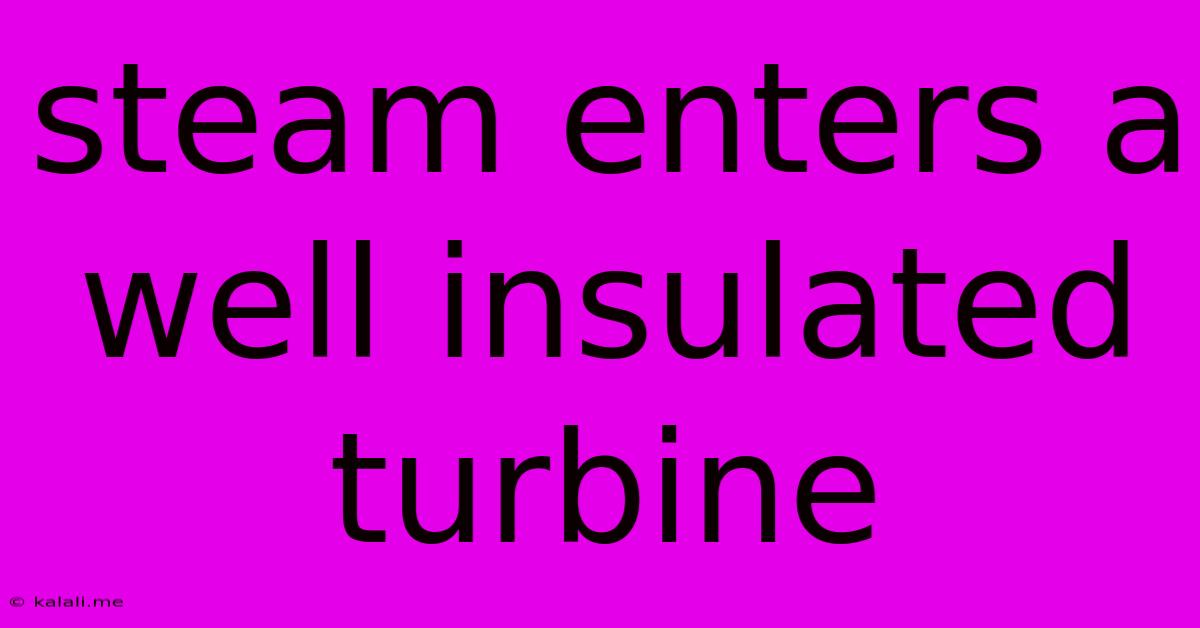Steam Enters A Well Insulated Turbine
Kalali
Jun 13, 2025 · 3 min read

Table of Contents
Steam Enters a Well-Insulated Turbine: Understanding the Adiabatic Process
This article explores the thermodynamic process that occurs when steam enters a well-insulated turbine, focusing on the adiabatic expansion and its implications for power generation. Understanding this process is crucial for engineers designing and optimizing steam turbines for maximum efficiency. We will delve into the concepts of enthalpy, entropy, and the isentropic efficiency, illustrating how these factors affect the performance of the turbine.
What Happens When Steam Enters a Well-Insulated Turbine?
When steam, a high-pressure, high-temperature fluid, enters a well-insulated turbine, it undergoes an adiabatic expansion. This means that no heat is exchanged between the steam and its surroundings. The insulation minimizes heat transfer, ensuring the process remains largely adiabatic. As the steam expands, it pushes against the turbine blades, causing them to rotate and generate mechanical work. This rotational energy is then typically used to drive a generator, producing electricity.
The key characteristic of an adiabatic process is that the change in enthalpy is equal to the work done by the steam. This relationship is fundamental to understanding the energy conversion process within the turbine. The steam's high enthalpy, a measure of its total energy content, is converted into kinetic energy (rotation of the turbine) and ultimately electrical energy.
Understanding the Thermodynamic Principles
Several key thermodynamic concepts govern the behavior of steam within a well-insulated turbine:
-
Enthalpy (h): Represents the total energy content of the steam, including internal energy and the product of pressure and volume. During adiabatic expansion, the enthalpy decreases as the steam does work.
-
Entropy (s): A measure of the disorder or randomness of a system. In an ideal, reversible adiabatic process (isentropic expansion), the entropy remains constant. However, real-world processes are irreversible, leading to an increase in entropy.
-
Isentropic Efficiency: This crucial parameter quantifies the performance of the turbine. It compares the actual work done by the turbine to the work that would be done under ideal (isentropic) conditions. A higher isentropic efficiency indicates better turbine performance. It's calculated by comparing the actual enthalpy drop to the isentropic enthalpy drop.
-
Pressure and Temperature: These parameters change significantly during the expansion process. As the steam expands, its pressure and temperature decrease. This pressure drop drives the turbine's operation.
Factors Affecting Turbine Performance
Several factors can affect the performance of a steam turbine, even under well-insulated conditions:
-
Turbine Design: The design of the turbine blades, including their shape and arrangement, significantly impacts the efficiency of energy conversion.
-
Steam Quality: The quality of the steam (the proportion of vapor to liquid) entering the turbine affects its performance. Wet steam (containing liquid water) can cause erosion and reduce efficiency.
-
Friction Losses: Friction between the steam and the turbine blades and within the steam itself leads to energy losses, reducing the overall efficiency.
-
Leakage: Leakage of steam around the turbine blades also results in energy loss and reduced efficiency.
Conclusion
The process of steam expanding within a well-insulated turbine is a complex interplay of thermodynamic principles, primarily governed by adiabatic expansion. While the ideal scenario is an isentropic process, real-world turbines experience irreversibilities, resulting in entropy generation and reduced isentropic efficiency. Understanding these principles and the various factors affecting turbine performance is essential for designing and optimizing high-efficiency power generation systems. Further investigation into specific turbine designs and operating conditions can provide a deeper understanding of this critical process in power generation.
Latest Posts
Latest Posts
-
Chondrocytes Are Found In Cavities Called
Jun 14, 2025
-
Average Sat Score For University Of Colorado Boulder
Jun 14, 2025
-
1 Bar Is Equal To How Many Pascal
Jun 14, 2025
-
What Is Estimation In Civil Engineering
Jun 14, 2025
-
Least Common Multiple Of 4 8 And 10
Jun 14, 2025
Related Post
Thank you for visiting our website which covers about Steam Enters A Well Insulated Turbine . We hope the information provided has been useful to you. Feel free to contact us if you have any questions or need further assistance. See you next time and don't miss to bookmark.